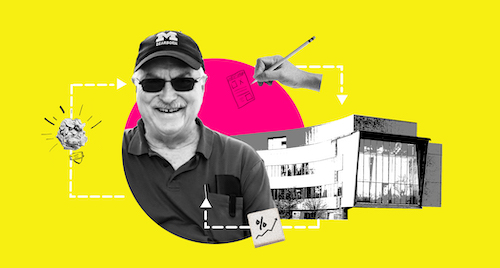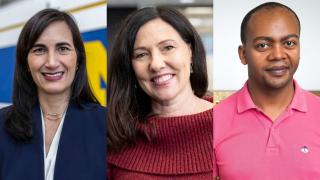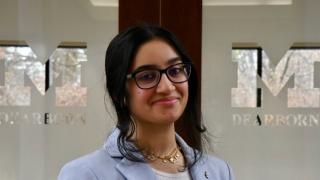
Needless to say, this is not how Tony England’s final year at UM-Dearborn was supposed to go. Without a global pandemic, the retiring dean of the College of Engineering and Computer Science would have been celebrating the grand opening of a new flagship Engineering Lab Building — a fitting capstone to his transformative eight-year tenure here. Instead, he’s spent much of the past six months in a continuous stream of Zoom calls, figuring out ways to keep his students and faculty safe, while keeping the quality of one of the most hands-on educational experiences at UM-Dearborn as high as possible. When we talked with him a few weeks ago, he admitted he’s not at all unhappy to be handing off videoconferencing duties to new CECS Interim Dean Ghassan Kridli this week. Nor does he have any doubts that Kridli and the team of young and veteran faculty surrounding him have everything they need to keep the momentum going. England has definitely given them a solid foundation, one of many things we asked the dean to reflect on in his “exit interview” with us below.
We definitely want to talk with you about all the transformative work you did here, but first, how have you been doing these past few months? I know this probably isn’t how you expected to be spending them.
Well, you’d think you would have this feeling of “gaining time” from not having a commute, which for me was about 40 minutes each way. But I realize now it was a relaxed 40 minutes. I would skip the expressway and go down Hines Drive— when it wasn’t flooded — and it gave me time to think about anything I wanted to. Now, my day consists of almost back-to-back BlueJeans or Zoom or Google meetings. I don’t know what it is, but you get to the end of the day and you’re just wrung out. The job has to be more than just meetings. There has to be a creative element, and that only occurs if you have time to think about things, or if you’re working with other people on a creative idea. This COVID thing has been all consuming, so I don’t envy folks that have to continue managing it because it’s a very difficult time.
I think we do have a viable plan for the fall. It is particularly challenging for us because the very persona of our college is very hands-on. We’ve spent a lot of effort investing in how we can teach online in a quality way, and studies have shown that if done right, teaching online can be just as effective. But that can’t replace the experiential part. So we really felt like this fall, we had to find a safe way to open our teaching labs. With Senior Design, for example, you have to have the experience of building a prototype, and having it not work the first time, and then figuring out how to make it work. That’s just part of the process. So we’re hoping by keeping densities low, we can still have these critical undergraduate courses that allow the students to go out into the world with the skills we’ve promised.
I get the sense there was a lot of excitement when you came to UM-Dearborn because you had this adventure-packed resume. You had been an astronaut with NASA. You’d worked in Antarctica with the U.S. Geological Survey. And, of course, you had a long career at U-M. So there was this sense you were a guy who could really shake things up. I’m curious, though, how did you view the job when you decided to come here?
Well at the time, I had recently stepped down as Associate Dean for Academic Affairs for the College of Engineering on the Ann Arbor campus. The provost from Dearborn came by and asked me if I’d consider serving two years as interim dean, but I wasn’t too hot on the idea because I really wanted to go back to research and teaching. Then I got a call from U-M President Mary Sue Coleman, and she said she thought I ought to do it. You get a call like that and it’s pretty hard to say ‘no.’
That’s the reason I came here. But the reason I stayed — we say this all the time, and I actually believe it deeply — is that we are transforming the lives of the students who come through here. When I got here, it was obvious that the seeds of something special were always here. For example, never in my time in Ann Arbor did I see undergraduate students, as I did here, return to celebrate a faculty retirement. You might see that with graduate students, but not with undergraduates. And in my 24 years in Ann Arbor, I wrote plenty of letters of recommendation and got back some thank you notes. But here, I actually had a student write me once and thank me for “giving them a future.” Something that emotional and earnest sticks with you.
When I arrived here, though, I thought of it a little like that fable of the frog and the hot water: Over the years, we had slowly dropped behind the current state of engineering education — both in facilities and the way we were teaching. I remember the old Engineering Lab Building, and our senior design and competitive teams working in these dirty spaces in the back of the building. It looked like a 1950s garage with stuff just stacked all over the place. You couldn’t get by operating that way in an industrial research facility or a modern factory. So we were showing students the wrong thing. And it was about slowly building up an understanding here on campus of what was missing, and what our potential was.
And to you, what was that? What was your vision for how to reinvent the college?
I never really wanted to just make Dearborn into Ann Arbor. My feeling was that we needed a differentiator, and the vision I had was more like the German universities that work very closely with industry. Paying attention to what industry’s biggest needs were, and things like internships and co-ops — those were the things that I thought could really put our students ahead. Today, about 70 percent of our research is sponsored by industry, so we’ve made great progress on that front. The other thing I felt was important is that we needed to break down the silos that separate disciplines, so that the students had a holistic vision of what engineering is. Engineering is not just designing a widget, it’s understanding how that widget solves a problem, and that requires the social sciences, philosophy, the natural sciences, business and education. In fact, before we built the new Engineering Lab Building, we were offered the donation of a modern building a few miles away, and there was some thought that we should move the engineering college over there. But had we done that, it would likely have killed the possibility of a more holistic engineering program. Instead, we built the ELB — and we designed it so it would not only serve our students, but artists and designers and students from other disciplines who might, say, want to use our maker space. That’s the kind of mixing of people and ideas that ultimately makes the best engineers.
I know one of the other big priorities you had as dean was tackling the diversity issues within the college. Can you talk about that and evaluate where we’re at today?
We’ve made some progress with faculty. When I started, we had two women faculty, and we have 12 now. But that’s out of 80, so it’s not where we ought to be. We also started out at 12 percent women undergraduate students, and now we’re at 22 percent. So that's better, but Ann Arbor is in the high twenties. And MIT and Harvey Mudd are at 50 percent, so we haven’t reached our potential quite yet. But it’s interesting to me how many women are leading our competitive teams. The MASA team — the rocket team — is led by a woman. And the team that won so many things in Formula SAE Combustion back in 2016 was led by a woman business major. So I think the women who do come here are having meaningful experiences and finding a realistic path to graduation.
Where we haven’t done well is with African American students. When I got here, representation in the program was 5 percent, and we’re still at 5 percent. Now we’ve doubled enrollment, so the numbers have doubled. But if our demographics reflected our draw area, and say our draw area encompasses a 15-mile radius, we would have 27 percent African American students in our college. In fact, in my last annual report, I did a SWOT [Strengths-Weaknesses-Opportunities-Threats] analysis, and one our weaknesses is that we’re not representing our region. I think we absolutely have to find a way to do better.
And do you have thoughts about why we’ve struggled and what it would take to build a more representative student body in the college?
I’ve been pressing for a program modeled after the Meyerhoff program that was created by the University of Maryland, Baltimore County, which other institutions like Penn State have now started to emulate. This was a program that was founded in the late 1980s to help foster success in STEM fields among minorities, particularly African Americans. And the approach is basically that the students come in as a cohort, and your responsibility as a student is to be successful as a cohort. This idea of pulling together as a collective, rather than intensely competing with your colleagues, seems to be much more effective among groups who have been historically marginalized or oppressed. You see a very similar approach with many programs at HBCUs. I mean, we have students in the Detroit area whose families are paying full tuition at out-of-state institutions, and why are they paying for that? It’s because their success rates at the HBCUs are so high. So imagine now we had a program that focused on serving disadvantaged students that, like these programs, had a 90 percent success rate. If we had such a thing at Dearborn, I think it would be like a beacon for the communities we are supposed to be serving. So I think we have to be much bolder, and focus on ideas with a history of success.
Your excitement about new ways of doing things seems to be something that’s guided your career. As you know, there’s a lot of talk about engineering education itself being at a crossroads. Where do you feel like the college is headed?
If I were to describe Ann Arbor’s ideal undergraduate, it would probably be someone who goes to graduate school and becomes a professor someplace, preferably at Harvard or MIT. And through those universities, those people could influence national and international policies. At Dearborn, our desired outcome is somebody who goes into industry, maybe picks up a Doctor of Engineering along the way, and becomes the head of some big organization or company that has a great influence on the direction of the country. As I mentioned before, the vision is to develop this closeness to industry, so that the college can enable significant industries to grow alongside them. Stanford is a great example; there would be no Silicon Valley without Stanford. I’m not saying we’re going to be a Stanford any time soon, but we can play a significant role in the industrial successes of Michigan.
Recognizing this potential starts guiding how you teach and what you teach. If you're trying to develop leaders, you can’t just be training people to design widgets. That will always be very important, and we want to make sure we always have a place for students who just love to design and build things. But we also want to make sure we have programs for what Chancellor Grasso refers to as the “holistic engineer.” What he means by that is somebody who is comfortable working across boundaries. It’s a person who understands that an engineering problem is a human problem, not just a technical problem — and you must know how to talk to the social scientists, and the artists, the business people, the environmentalists. That’s what we’re trying to do now, and our new human-centered design focused programs are essentially prototypes for how we think we can get there. Incidentally, that’s not an idea we’re pursuing just because we want to start some trendy new program. It actually came out of us listening to one of our partners in industry, who was struggling with a shortage of design engineers. When we looked into it, there really wasn’t anyone in the state offering this kind of human-centered design approach. So I think that’s a great example of what I think our trademark can be. It’s about giving our students an experience that resembles as closely as possible the world of engineering as it exists today and how it will be practiced in the future.




